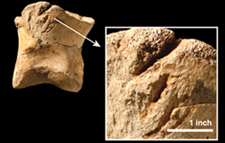T. rex: Flexibler Kopf
Fleischfressender Dinosaurier besaß einzigartigen Schädel
Senckenberg-Wissenschaftler Ingmar Werneburg hat mit einem internationalen Team erstmalig die Schädelkonstruktion des Tyrannosaurus rex untersucht. Mit Hilfe einer “Anatomischen Netzwerk Analyse” zeigen sie in ihrer heute im Fachjournal “Scientific Reports” erschienenen Studie, dass die Schädelstruktur des fleischfressenden Dinosauriers sehr komplex war. Verschiedene Knochenmodule führten zu einer Flexibilität des Schnauzenteils, welche beim Zerlegen von Beutetieren hilfreich war. (more…)

